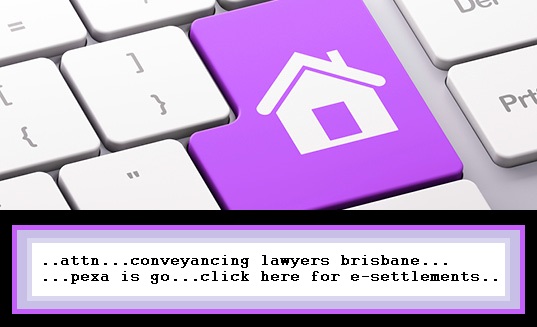By Remy Forster
In December of 2016 Just Us Lawyers completed the firm’s first electronic conveyancing settlement through the PEXA system. We have previously written about how e-conveyancing has the potential to simplify conveyancing settlements (see our blog from September 2016 The advent of e-conveyancing) and there’s no better way to decide on the usefulness of e-conveyancing then using it. So how well did the expectations we have of e-conveyancing hold up in reality? The truth is, not as well as expected. None of the potential problems with e-conveyancing affected this specific settlement in the end, but using the PEXA system did reveal a number of issues with the Queensland electronic conveyancing system that have yet to be fine-tuned.
At present, PEXA is deliberately set up so that an electronic settlement cannot occur until the solicitors acting for the Buyer have set up details with the Office of State Revenue’s (OSR) online system regarding transfer duty for that specific transaction. This is not a bad idea in itself, as under a paper conveyance, the Buyers’ solicitors would set up the transfer duty details with the OSR prior to settlement in any case. However, in the case of our first electronic settlement there was a glitch in how the PEXA system communicated with the electronic system used by the OSR. For this particular glitch, PEXA, the Buyers’ solicitors and the OSR were able to work together to have the issue resolved prior to settlement; but for a considerable amount of time, it looked like the glitch would not be able to be fixed and the settlement would not be able to proceed electronically.
This issue arising has revealed the current two biggest problems with agreeing to settle a conveyancing matter electronically. The first is that the PEXA system relies on other electronic systems, such as those used by the OSR and the Department of Natural Resources and Mines (DNRM), to work seamlessly with the PEXA system. An arrangement like this is very achievable and other states in Australia already have these systems in place. However, for Conveyancing Lawyers in Brisbane, until either a considerable amount of time passes or the amount of electronic settlements drastically increases, it may take a while for any glitches in the systems to be worked out.
When these glitches cannot be rectified, a second problem occurs – that the conveyancing settlement has to be reverted back to a paper settlement. If the parties are given a suitable amount of notice that the settlement cannot proceed electronically, reverting back to a paper settlement isn’t much of an issue – but as most residential conveyancing settlements in Queensland are 30 days settlements, there is a high chance this time won’t be available. Additionally, most banking institutions which allow PEXA settlements appear to have made changing a conveyancing settlement from electronic to paper unnecessarily complicated and lengthy. For example, the banking institution involved in our particular electronic settlement advised us that it could take up to 10 business days for their teams to change the settlement from an electronic to a paper settlement in their systems. Further, changing from an electronic to paper settlement also requires original documents to be signed by the parties (prior to settlement) that are not needed for electronic settlements. If one or both of the parties are located overseas, interstate or regionally or otherwise unable to sign the settlement documents at short notice, this could result in settlement delays. The obvious solution to concerns with settlements being reverted from electronic to paper, without much notice, is for the solicitors involved in the transaction to ensure they are able to proceed with settlement by both means. If the electronic settlement should be unable to proceed both parties are then prepared for a paper settlement. Having to do this does defeat some of the benefits to the parties involved in settling a conveyancing matter electronically, but allows more protection to the parties’ ability to settle by the required settlement date. Another alternative, to avoid last minute glitches, is for the solicitors to both parties to have all aspects of the PEXA settlement that require interaction with other electronic systems ready two or three weeks prior to settlement – but even then, there is no guarantee that a glitch won’t develop closer to settlement.
Despite the above, all other aspects of the electronic conveyancing proceeded without error and the benefits of electronic conveyancing were made very clear. As the Sellers’ solicitors, we received notifications from the PEXA system whenever items were required to be completed, communication in the online PEXA message system was seamless and our clients received the proceeds of their sale as cleared funds in their bank account within hours of the settlement occurring. It was also with pleasure that we watched the PEXA system notify us only two days after settlement that the property was already in the name of the new owners, as opposed to the two or three months that this can take to occur for a paper settlement.
Overall it is definitely still worth arranging conveyancing matters to settle electronically, both to allow practitioners and clients to become used to how electronic settlements proceed and to test the usage of the PEXA system. The above being the only main issues which arose in our first electronic conveyance shows how strong the PEXA system is already, and we have high hopes that with more usage in the conveyancing sector that it will only be a matter of time before glitches in PEXA electronic conveyances are a matter of the past.
Just Us Lawyers – for the best Conveyancing lawyers in Brisbane call/email Just Us Lawyers or complete our enquiry form for a quote today





